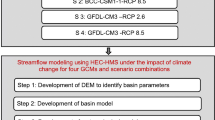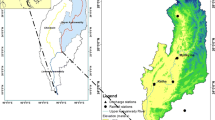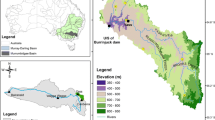Abstract
HydroClimatic Conceptual Streamflow (HCCS) model is a conceptual model for prediction and future assessment of daily streamflow using climate inputs and time-varying watershed characteristics. However, without denying its useful salient features in a changing climate, applicability of the HCCS model is limited to the basins without any major man-made river structure(s), such as reservoirs. Considering this, the originally proposed HCCS model is upgraded (hereinafter ‘upgraded HCCS model’) to accommodate the human-intervened release from such structures within the basin, if any, and to include routing component through the river channels without using rigorous information from the river channels. The upgraded HCCS model is expected to be useful to assess (i) the effect on the streamflow at downstream due to upstream dam release, and (ii) the long-term modification required in the reservoir/dam operation under a changing climate for ensuring water-availability in downstream. The upgraded HCCS model is applied to three river basins for assessing the future streamflow characteristics. Two of these basins have one each and the third basin has two major man-made river structures within them. Hadley Centre Coupled Model, version 3 (HadCM3) simulated climate variables till 2035 are used as inputs for demonstration. The model predicts an increase in streamflow in future. In general, the upgraded HCCS model can be applied to any tropical river basin having major man-made river structure(s) for daily streamflow prediction as well as assessment of future streamflow variation considering the changing climate and watershed characteristics.





Similar content being viewed by others
References
Abdollahi S, Raeisi J, Khalilianpour M, Ahmadi F, Kisi O (2017) Daily mean streamflow prediction in perennial and non-perennial rivers using four data driven techniques. Water Resour Manag 31(15):4855–4874
Anderson EA (1973) National Weather Service River forecast system–snow accumulation and ablation model, Technical Memorandum NWS Hydro-17, November 1973
Bhagwat PP, Maity R (2014) Development of HydroClimatic conceptual streamflow (HCCS) model for tropical river sub-basin. J Water Clim Chang 5(1):36–60
Bicknell BR, Imhoff JC, Kittle Jr JL, Donigian Jr AS, Johanson RC (1996) Hydrological simulation program-FORTRAN. User's manual for release 11. US EPA
Boggs PT, Tolle JW (2000) Sequential quadratic programming for large-scale nonlinear optimization. J Comput Appl Math 124(1):123–137
Bultot F, Dupriez GL (1976) Conceptual hydrological model for an average-sized catchment are, I. concepts and relationships. J Hydrol 29:251–272. https://doi.org/10.1016/0022-1694(76)90040-8
Chow VT, Maidment DR, Mays LW (1988) Applied hydrology. McGraw-Hill, New York
Costelloe JF, Grayson RB, Argent RM, McMahon TA (2003) Modelling the flow regime of an arid zone floodplain river, Diamantina River, Australia. Environ Model Softw 18(8–9):693–703
Crawford NH, Linsley RK (1966) Digital simulation in hydrology: Stanford watershed model IV. Stanford University Tech. Report 39
Grizzetti B, Bouraoui F, Granlund K, Rekolainen S, Bidoglio G (2003) Modelling diffuse emission and retention of nutrients in the Vantaanjoki watershed (Finland) using the SWAT model. Ecol Model 169(1):25–38
IPCC (2013) AR5 Ref Data, Intergovernmental Panel on Climate Change, Available on http://www.ipcc-data.org/sim/gcm_monthly/AR5/Reference-Archive.html. Accessed 5th Jan 2016
Isik S, Kalin L, Schoonover JE, Srivastava P, Lockaby BG (2013) Modeling effects of changing land use/cover on daily streamflow: an artificial neural network and curve number based hybrid approach. J Hydrol 485:103–112
Kalteh AM (2016) Improving forecasting accuracy of streamflow time series using least squares support vector machine coupled with data-preprocessing techniques. Water Resour Manag 30(2):747–766
Kisi O (2016) Discussion of “Monthly Mean Streamflow Prediction Based on Bat Algorithm-Support Vector Machine” by Bing Xing, Rong Gan, Guodong Liu, Zhongfang Liu, Jing Zhang, and Yufeng Ren. J Hydrol Eng, 07016010
Lawrence DM, Oleson KW, Flanner MG, Thornton PE, Swenson SC, Lawrence PJ, Zeng X, Yang ZL, Levis S, Skaguchi K, Bonan GB (2011) Parameterization improvements and functional and structural advances in version 4 of the Community Land Model. J Advances in Model Earth Syst 3(1). https://doi.org/10.1029/2011MS00045
Maity R, Kashid SS (2010) Short-term sub-basin-scale streamflow forecasting using large-scale coupled atmospheric-oceanic circulation and local outgoing longwave radiation. J Hydrometeorol 11(2):370–387
Maity R, Bhagwat PP, Bhatnagar A (2010) Potential of support vector regression for prediction of monthly streamflow using endogenous property. Hydrol Process 24(7):917–923. https://doi.org/10.1002/hyp.7535
Mehr AD, Kahya E, Yerdelen C (2014) Linear genetic programming application for successive-station monthly streamflow prediction. Comput Geosci 70:63–72
Moss R, Babiker W, Brinkman S, Calvo E, Carter T, Edmonds J, Elgizouli I, Emori S, Erda L, Hibbard K, Jones RN (2008) Towards new scenarios for the analysis of emissions: Climate change, impacts and response strategies. IPCC Expert Meeting Report on New Scenarios. Intergovernmental Panel on Climate Change, Noordwijkerhout
Nagesh Kumar D, Reddy MJ, Maity R (2007) Regional rainfall forecasting using large scale climate teleconnections and artificial intelligence techniques. J Intell Syst 16(4):307–322
Neitsch SL, Arnold JG, Kiniry JR, Williams JR (2011) Soil and water assessment tool theoretical documentation version 2009. Texas Water Resources Institute
Nocedal J, Wright S (2006) Numerical optimization. Springer Science & Business Media, New York
Pai DS, Sridhar L, Rajeevan M, Sreejith OP, Satbhai NS, Mukhopadhyay B (2014) Development of a new high spatial resolution (0.25° X 0.25°)long period (1901–2010) daily gridded rainfall data set over India and its comparison with existing data sets over the region. Mausam 65(1):1–18
Piotrowski AP, Napiorkowski JJ (2012) Product-units neural networks for catchment runoff forecasting. Adv Water Resour 49:97–113
Poter JW, McMahon TA (1976) The Monash model user manual for daily program HYDROLOG. Dept of Civil Eng Monash University vic. Res, Rep. 2/76,41
Shiau J-T, Hsu H-T (2016) Suitability of ANN-based daily streamflow extension models: a case study of Gaoping River basin, Taiwan. Water Resour Manag 30:1499–1513. https://doi.org/10.1007/s11269-016-1235-8
Srivastava AK, Rajeevan M, Kshirsagar SR (2009) Development of a high resolution daily gridded temperature data set (1969-2005) for the Indian region. Atmos Sci Lett. https://doi.org/10.1002/asl.232
Stern M, Flint L, Minear J, Flint A, Wright S (2016) Characterizing changes in streamflow and sediment supply in the Sacramento River basin, California, using hydrological simulation program—FORTRAN (HSPF). Water 8(10):432
van Vuuren DP, Edmonds J, Kainuma M, Riahi K, Thomson A, Hibbard K, Hurtt GC, Kram T, Krey V, Lamarque JF, Masui T (2011) The representative concentration pathways: an overview. Clim Chang 109(1–2):5
Wang WC, Chau KW, Cheng CT, Qiu L (2009) A comparison of performance of several artificial intelligence methods for forecasting monthly discharge time series. J Hydrol 374(3):294–306
WRIS (2015) Hydro Observation Station Sub Info System, Water Resources Information System, India, Available on http://www.India-wris.nrsc.gov.in/wris.html. Accessed 10th Oct 2015
Acknowledgements
This work was partially supported by the Department of Science and Technology, Climate Change Programme (SPLICE), Government of India (Ref No. DST/CCP/CoE/79/2017(G)) through a sponsored project.
Author information
Authors and Affiliations
Corresponding author
Ethics declarations
Conflict of Interest
Authors declare that there is no conflict of interest.
Research Involving Human Participants and/or Animals
The authors declare that the research does not contain any studies with human participants or animals performed by any of the authors.
Informed Consent
The authors declare that the ‘Informed Consent’ is not applicable in the research since it does not contain any studies with human participants or animals performed by any of the authors.
Additional information
Publisher’s Note
Springer Nature remains neutral with regard to jurisdictional claims in published maps and institutional affiliations.
Electronic supplementary material
ESM 1
(PDF 2446 kb)
Rights and permissions
About this article
Cite this article
Suman, M., Maity, R. Assessment of Streamflow Variability with Upgraded HydroClimatic Conceptual Streamflow Model. Water Resour Manage 33, 1367–1382 (2019). https://doi.org/10.1007/s11269-019-2185-8
Received:
Accepted:
Published:
Issue Date:
DOI: https://doi.org/10.1007/s11269-019-2185-8




